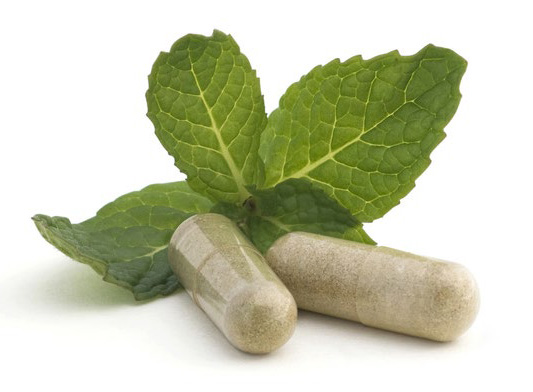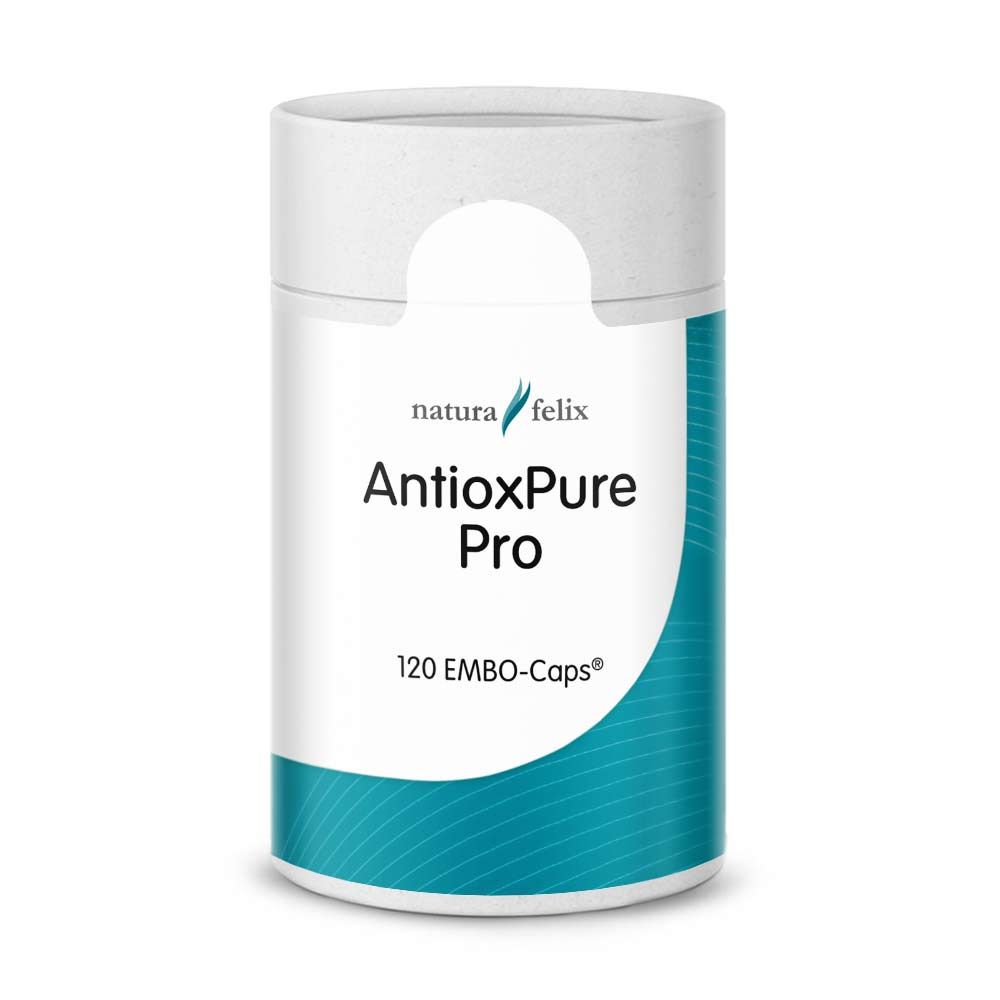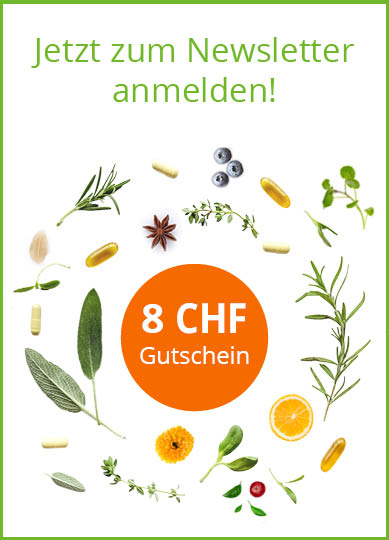Premium-Qualität vom Vitalstoffspezialist
 Natürlich und rein
Natürlich und rein  Keine Zusatzstoffe
Keine Zusatzstoffe  Hohe Bioverfügbarkeit
Hohe Bioverfügbarkeit 
Premium-Qualität vom Vitalstoffspezialist
 Natürlich und rein
Natürlich und rein  Keine Zusatzstoffe
Keine Zusatzstoffe  Hohe Bioverfügbarkeit
Hohe Bioverfügbarkeit 


natura felix AntioxPure Pro
Bestell-Nr.
57292| 120 EMBO-CAPS®
●
Sofort lieferbar
Lieferzeit:
2-3 Tage
Die Experten-Formel für Ihren Zellschutz!
Unsere Zellen sind die Bausteine des Lebens. Sie erneuern sich ständig, produzieren Energie und wehren Angriffe ab. Sogenannte freie Radikale - aggressive Moleküle - können diese Strukturen schädigen und in ihre Funktion beeinträchtigen. Mögliche Folgen sind beschleunigte Alterungsprozesse und eine Schwächung der körpereigenen Abwehrkräfte.Genau hier setzt felix natura AntioxPure Pro an. Die Kombination aus Vitaminen, Spurenelementen und Pflanzenextrakten unterstützt gezielt den Schutz der Zellen vor oxidativem Stress und trägt zu einer normalen Funktion des Immunsystems bei. Hier vereinen wir bewährte Antioxidantien wie die Vitamine C und E mit spezialisierten Pflanzenstoffen wie Astaxanthin, OPC und EGCG. Mit felix natura AntioxPure Pro können die Stärkung der zellulären Widerstandskraft und die Förderung des Wohlbefindens erreicht werden.
- Umfassender Zellschutz durch systemisch wirkende Antioxidantien [s3]
- Hilft, die normale Funktion des Immunsystems aufrechtzuerhalten [s4], [s5], [s6]
- Fokus auf gut bioverfügbare Wirkstoffformen und standardisierte Extrakte [s7], [s8], [s9], [s10], [s11]
- Breites antioxidatives Spektrum durch wasser- und fettlösliche Komponenten [s12], [s13]
So unterstützt felix natura AntioxPure Pro Ihre Zellen
Bei normalen Stoffwechselvorgängen und durch äußere Einflüsse wie UV-Strahlung oder Schadstoffe entstehen reaktive Sauerstoffspezies (ROS). Diese sogenannten freien Radikale können DNA, Proteine und Zellmembranen schädigen. [s14].Der Körper schützt sich durch antioxidative Systeme, zu denen enzymatische Mechanismen (z.B. Superoxiddismutase) und nicht-enzymatische Substanzen (z.B. Vitamin C, Vitamin E) zählen. Ein Übermaß an ROS bei unzureichender Abwehr führt zu oxidativem Stress - einem Zustand, der mit der Entstehung zahlreicher Erkrankungen wie Atherosklerose oder neurodegenerativen Prozessen in Verbindung gebracht wird.[s15].
Die gezielte Zufuhr antioxidativer Mikronährstoffe kann helfen, das Gleichgewicht wiederherzustellen - insbesondere bei erhöhter Belastung oder unzureichender Zufuhr über die Ernährung.
Vitamin C: Ascorbinsäure wirkt in wässrigen Zellkompartimenten als Radikalfänger, Ascorbylpalmitat hingegen ist in fettlöslichen Strukturen wie Zellmembranen aktiv. Durch diese gezielte Verteilung tragen beide Formen zur Neutralisierung freier Radikale in unterschiedlichen zellulären Umgebungen bei und unterstützen so den umfassenden antioxidativen Schutz. [s16] Darüber hinaus spielt es eine zentrale Rolle bei der Regeneration von Vitamin E. Es wandelt verbrauchtetes Vitamin E wieder in seine aktive, antioxidativ wirksame Form um. [s17].
Vitamin E: Wird aus der Sonnenblume gewonnen. Es ist ein fettlösliches Antioxidans, das Zellmembranen schützt. Insbesondere bewahrt es die darin enthaltenen Fettbestandteile (Lipide) vor oxidativen Schäden. [s18] Diese Schutzfunktion kann durch Vitamin C ergänzt werden [s17].
Zink: In Form von Picolinat, das für seine gute Bioverfügbarkeit bekannt ist. [s7] Zink ist ein essenzieller Bestandteil des körpereigenen Enzyms Kupfer-Zink-Superoxiddismutase (Cu/Zn-SOD). Dieses Enzym ist für die Neutralisation von Superoxidradikalen, einer spezifischen Form reaktiver Sauerstoffspezies, verantwortlich.[s19]. Das Spurenelement ist darüber hinaus an der Erhaltung der strukturellen Stabilität von Zellmembranen beteiligt, was für den menschlichen Körper essenziell ist. [s20].
Selen: Als Methionin-Verbindung[s8], ist Selen in einer gut bioverfügbaren Form vorhanden. Selen übernimmt im Körper essenzielle Funktionen, insbesondere als Bestandteil bestimmter antioxidativer Enzyme wie der Glutathionperoxidase. [s21]. Diese Enzyme tragen dazu bei, reaktive Sauerstoffverbindungen zu neutralisieren und leisten damit einen wichtigen Beitrag zum Schutz der Zellen vor oxidativem Stress.[s22].
Beta-Carotin & Lycopin: Gehören zur Gruppe der Carotinoide. Das sind natürliche Farbstoffe, die von Pflanzen gebildet werden. Sie tragen durch ihre antioxidativen Eigenschaften dazu bei, die Zellen vor schädlichen freien Radikalen zu schützen, die für Schäden an der Zelle verantwortlich sind. [s23]. Beta-Carotin dient zudem als Provitamin A.
Astaxanthin: Dieses aus der Mikroalge Haematococcus pluvialis gewonnene Carotinoid zeichnet sich durch eine besondere molekulare Struktur aus. Diese Struktur ermöglicht es Astaxanthin, sich in der gesamten äußeren Hülle der Zellen zu verteilen. Auf diese Weise kann es freie Radikale direkt in allen Bereichen dieser Zellhülle neutralisieren [s24], das umfassenden Membranschutz bietet [s25].
Oligomere Proanthocyanidine (OPC): Dieser wertvolle Pflanzenstoffe [s10] aus Traubenkernextrakt ist bekannt dafür, freie Radikale zu neutralisieren. Darüber hinaus kann er die antioxidative Wirkung von Vitamin C unterstützen und dessen Effektivität beim Zellschutz positiv beeinflussen. [s26]
Rosmarin: Die enthaltene Carnosolsäure kann zum einen freie Radikale direkt neutralisieren [s11]. Zum anderen gibt es Hinweise, dass Rosmarinextrakt die zelleigene Bildung antioxidativer Stoffe beeinflussen kann [s13], [s27].
Grüntee: Der Extrakt enthält Epigallocatechingallat (EGCG) [s9]. Diese kann freie Radikale neutralisieren. Da diese schädlichen Moleküle in verschiedenen Formen auftreten, ist es entscheidend, nicht nur eine einzelne Verbindung, sondern ein möglichst breites Spektrum freier Radikale zu neutralisieren. Studien weisen zudem darauf hin, dass freie Radikale auch zelluläre Prozesse beeinflussen können, die für die normale Funktion der Zellen von Bedeutung sind. [s28]."
Artischocke: Zu den im Extrakt enthaltenen Bestantteilen gehört unter anderem Cynarin. [s29] Dieser Stoff besitzt antioxidative Eigenschaften. Wissenschaftliche Untersuchungen zeigen, dass diese Substanzen zudem die Funktion der Leberzellen positiv beeinflussen und zu deren antioxidativer Kapazität beitragen können.[s30].
Starten Sie Ihr Programm für zelluläres Wohlbefinden
Unsere Zellen sind die Basis unserer Gesundheit und täglich oxidativem Stress ausgesetzt. Es ist an der Zeit, ihnen die Unterstützung zu geben, die sie verdienen. Mit felix natura AntioxPure Pro unterstützen Sie Ihre Zellen auf natürliche Weise und helfen, sie vor den Folgen freier Radikale zu schützen. Die einzigartige Kombination aus Vitaminen, Spurenelementen und Pflanzenextrakten schützt die Zellen, unterstützt das Immunsystem und fördert die Vitalität.Ihre Zellen leisten Großartiges für Sie - Zeit, etwas zurückzugeben, finden Sie nicht auch?
DISCLAIMER: Das Zulassungsverfahren für diese gesundheitsbezogene Angabe für Kräuter ist noch nicht abgeschlossen.
FAQ:
F: Oxidativer Stress - was bedeutet das konkret für meinen Körper?
A: Freie Radikale sind Moleküle, die Zellen angreifen können [s14]. Ein Übermaß verursacht "oxidativen Stress".
F: Wie genau schützt felix natura AntioxPure Pro meine Zellen?
A: Es liefert eine Kombination aus Vitaminen (C, E), Mineralien (Selen, Zink) und Pflanzenextrakten, die als Antioxidantien agieren und so Schutz vor oxidativem Stress bieten [s3].
F: Kann ich damit auch mein Immunsystem gezielt unterstützen?
A: Ja. Vitamin C, Zink und Selen sind bekannte Unterstützer einer normalen Immunfunktion [s4], [s5], [s6]
F: Pflanzenextrakte - was ist ihr besonderer Beitrag in dieser Formulierung?
A: Extrakte wie OPC [s10], Astaxanthin [s24] oder EGCG [s9] sind besondere Komponenten: Sie liefern sekundäre Pflanzenstoffe, die das antioxidative Spektrum erweitern und synergistisch wirken können.
F: Für wen ist die Einnahme von felix natura AntioxPure Pro besonders überlegenswert?
A: Für alle, die aktiv etwas für ihre zelluläre Gesundheit tun und ihre körpereigene Abwehr sowie Vitalität mit einer durchdachten Nährstoffkombination unterstützen wollen.
[s1] Lobo, V., Patil, A., Phatak, A., & Chandra, N. (2010). Free radicals, antioxidants and functional foods: Impact on human health. Pharmacognosy reviews, 4(8), 118-126.
[s2] Wintergerst, E. S., Maggini, S., & Hornig, D. H. (2007). Contribution of selected vitamins and trace elements to immune function. Annals of Nutrition and Metabolism, 51(4), 301-323.
[s3] EFSA Panel on Dietetic Products, Nutrition and Allergies (NDA). (2010). Scientific Opinion on the substantiation of health claims related to vitamin C, vitamin E, zinc, and selenium and protection of DNA, proteins and lipids from oxidative damage [...]. EFSA Journal, 8(10), 1815.
[s4] EFSA Panel on Dietetic Products, Nutrition and Allergies (NDA). (2009). Scientific Opinion on the substantiation of health claims related to vitamin C and contribution to the normal function of the immune system [...]. EFSA Journal, 7(10), 1226.
[s5] EFSA Panel on Dietetic Products, Nutrition and Allergies (NDA). (2009). Scientific Opinion on the substantiation of health claims related to zinc and function of the immune system [...]. EFSA Journal, 7(10), 1229.
[s6] EFSA Panel on Dietetic Products, Nutrition and Allergies (NDA). (2009). Scientific Opinion on the substantiation of health claims related to selenium and function of the immune system [...]. EFSA Journal, 7(10), 1220.
[s7] Wegmüller, R., Tay, F., Zeder, C., Brnic, M., & Hurrell, R. F. (2014). Zinc absorption by young adults from supplemental zinc citrate is comparable with that from zinc gluconate and higher than from zinc oxide. The Journal of nutrition, 144(2), 132-136.
[s8] Rayman, M. P. (2012). Selenium and human health. The Lancet, 379(9822), 1256-1268.
[s9] Singh, B. N., Shankar, S., & Srivastava, R. K. (2011). Green tea catechin, epigallocatechin-3-gallate (EGCG): mechanisms, perspectives and clinical applications. Biochemical pharmacology, 82(12), 1807-1821.
[s10] Shi, J., Yu, J., Pohorly, J. E., & Kakuda, Y. (2003). Polyphenolics in grape seeds - biochemistry and functionality. Journal of medicinal food, 6(4), 291-299.
[s11] de Oliveira, J. R., Camargo, S. E. A., & de Oliveira, L. D. (2019). Rosmarinus officinalis L. (rosemary) as therapeutic and prophylactic agent. Journal of biomedical science, 26(1), 5.
[s12] Fiedor, J., & Burda, K. (2014). Potential role of carotenoids as antioxidants in human health and disease. Nutrients, 6(2), 466-488.
[s13] Satoh, T., & Lipton, S. A. (2017). Nrf2 in the pathogenesis of Alzheimer's disease and other neurodegenerative disorders. In Oxidative Stress and Antioxidant Defense: Nrf2 and its Role in Health and Disease (pp. 333-349). Academic Press.
[s14] Liguori, I., Russo, G., Curcio, F., Bulli, G., Aran, L., Della-Morte, D., ... & Abete, P. (2018). Oxidative stress, aging, and diseases. Clinical interventions in aging, 13, 757-772.
[s15] Sies, H. (2015). Oxidative stress: a concept in redox biology and medicine. Redox biology, 4, 180-183.
[s16] Padayatty, S. J., Katz, A., Wang, Y., Eck, P., Kwon, O., Lee, J. H., ... & Levine, M. (2003). Vitamin C as an antioxidant: evaluation of its role in disease prevention. Journal of the American College of Nutrition, 22(1), 18-35.
[s17] Carr, A. C., & Vissers, M. C. M. (2013). Synthetic or food-derived vitamin C are they equally bioavailable?. Nutrients, 5(11), 4284-4304.
[s18] Traber, M. G., & Atkinson, J. (2007). Vitamin E, antioxidant and nothing more. Free radical biology & medicine, 43(1), 4-15.
[s19] Valentine, J. S., Pantoliano, M. W., McDonnell, P. J., Burger, A. R., & Lippard, S. J. (1979). pH dependence of the copper and zinc nuclear magnetic resonance spectra of copper-zinc superoxide dismutase. Proceedings of the National Academy of Sciences, 76(9), 4245-4249.
[s20] Prasad, A. S. (2014). Zinc is an antioxidant and anti-inflammatory agent: its role in human health. Frontiers in nutrition, 1, 14.
[s21] Papp, L. V., Lu, J., Holmgren, A., & Khanna, K. K. (2007). From selenium to selenoproteins: synthesis, identity, and their role in human health. Antioxidants & redox signaling, 9(7), 775-806.
[s22] Brigelius-Flohé, R., & Maiorino, M. (2013). Glutathione peroxidases. Biochimica et Biophysica Acta (BBA) - General Subjects, 1830(5), 3289-3303.
[s23] Young, A. J., & Lowe, G. M. (2018). Carotenoids antioxidant properties. Antioxidants, 7(2), 28.
[s24] Ambati, R. R., Phang, S. M., Ravi, S., & Aswathanarayana, R. G. (2014). Astaxanthin: sources, extraction, stability, biological activities and its commercial applications - a review. Marine drugs, 12(1), 128-152.
[s25] Guerin, M., Huntley, M. E., & Olaizola, M. (2003). Haematococcus astaxanthin: applications for human health and nutrition. Trends in biotechnology, 21(5), 210-216.
[s26] Gupta, M., Dey, S., Marbaniang, D., Pal, P., Ray, S., & Mazumder, B. (2020). Grape seed extract: having a potential health benefits. Journal of food science and technology, 57(4), 1205-1215.
[s27] Kurutas, E. B. (2016). The importance of antioxidants which play the role in cellular response against oxidative/nitrosative stress: current state. Nutrition journal, 15(1), 71.
[s28] Khan, N., & Mukhtar, H. (2018). Tea polyphenols in promotion of human health. Nutrients, 11(1), 39.
[s29] Ben Salem, M., Affes, H., Ksouda, K., Dhouibi, R., Sahnoun, Z., Hammami, S., & Zeghal, K. M. (2015). Pharmacological studies of artichoke leaf extract and their health benefits. Plant foods for human nutrition, 70(4), 441-453.
[s30] Speroni, E., Cervellati, R., Govoni, P., Guizzardi, S., Renzulli, C., & Guerra, M. C. (2003). Efficacy of different Cynara scolymus preparations on functional dyspepsia. Journal of ethnopharmacology, 86(2-3), 203-211.
[s2] Wintergerst, E. S., Maggini, S., & Hornig, D. H. (2007). Contribution of selected vitamins and trace elements to immune function. Annals of Nutrition and Metabolism, 51(4), 301-323.
[s3] EFSA Panel on Dietetic Products, Nutrition and Allergies (NDA). (2010). Scientific Opinion on the substantiation of health claims related to vitamin C, vitamin E, zinc, and selenium and protection of DNA, proteins and lipids from oxidative damage [...]. EFSA Journal, 8(10), 1815.
[s4] EFSA Panel on Dietetic Products, Nutrition and Allergies (NDA). (2009). Scientific Opinion on the substantiation of health claims related to vitamin C and contribution to the normal function of the immune system [...]. EFSA Journal, 7(10), 1226.
[s5] EFSA Panel on Dietetic Products, Nutrition and Allergies (NDA). (2009). Scientific Opinion on the substantiation of health claims related to zinc and function of the immune system [...]. EFSA Journal, 7(10), 1229.
[s6] EFSA Panel on Dietetic Products, Nutrition and Allergies (NDA). (2009). Scientific Opinion on the substantiation of health claims related to selenium and function of the immune system [...]. EFSA Journal, 7(10), 1220.
[s7] Wegmüller, R., Tay, F., Zeder, C., Brnic, M., & Hurrell, R. F. (2014). Zinc absorption by young adults from supplemental zinc citrate is comparable with that from zinc gluconate and higher than from zinc oxide. The Journal of nutrition, 144(2), 132-136.
[s8] Rayman, M. P. (2012). Selenium and human health. The Lancet, 379(9822), 1256-1268.
[s9] Singh, B. N., Shankar, S., & Srivastava, R. K. (2011). Green tea catechin, epigallocatechin-3-gallate (EGCG): mechanisms, perspectives and clinical applications. Biochemical pharmacology, 82(12), 1807-1821.
[s10] Shi, J., Yu, J., Pohorly, J. E., & Kakuda, Y. (2003). Polyphenolics in grape seeds - biochemistry and functionality. Journal of medicinal food, 6(4), 291-299.
[s11] de Oliveira, J. R., Camargo, S. E. A., & de Oliveira, L. D. (2019). Rosmarinus officinalis L. (rosemary) as therapeutic and prophylactic agent. Journal of biomedical science, 26(1), 5.
[s12] Fiedor, J., & Burda, K. (2014). Potential role of carotenoids as antioxidants in human health and disease. Nutrients, 6(2), 466-488.
[s13] Satoh, T., & Lipton, S. A. (2017). Nrf2 in the pathogenesis of Alzheimer's disease and other neurodegenerative disorders. In Oxidative Stress and Antioxidant Defense: Nrf2 and its Role in Health and Disease (pp. 333-349). Academic Press.
[s14] Liguori, I., Russo, G., Curcio, F., Bulli, G., Aran, L., Della-Morte, D., ... & Abete, P. (2018). Oxidative stress, aging, and diseases. Clinical interventions in aging, 13, 757-772.
[s15] Sies, H. (2015). Oxidative stress: a concept in redox biology and medicine. Redox biology, 4, 180-183.
[s16] Padayatty, S. J., Katz, A., Wang, Y., Eck, P., Kwon, O., Lee, J. H., ... & Levine, M. (2003). Vitamin C as an antioxidant: evaluation of its role in disease prevention. Journal of the American College of Nutrition, 22(1), 18-35.
[s17] Carr, A. C., & Vissers, M. C. M. (2013). Synthetic or food-derived vitamin C are they equally bioavailable?. Nutrients, 5(11), 4284-4304.
[s18] Traber, M. G., & Atkinson, J. (2007). Vitamin E, antioxidant and nothing more. Free radical biology & medicine, 43(1), 4-15.
[s19] Valentine, J. S., Pantoliano, M. W., McDonnell, P. J., Burger, A. R., & Lippard, S. J. (1979). pH dependence of the copper and zinc nuclear magnetic resonance spectra of copper-zinc superoxide dismutase. Proceedings of the National Academy of Sciences, 76(9), 4245-4249.
[s20] Prasad, A. S. (2014). Zinc is an antioxidant and anti-inflammatory agent: its role in human health. Frontiers in nutrition, 1, 14.
[s21] Papp, L. V., Lu, J., Holmgren, A., & Khanna, K. K. (2007). From selenium to selenoproteins: synthesis, identity, and their role in human health. Antioxidants & redox signaling, 9(7), 775-806.
[s22] Brigelius-Flohé, R., & Maiorino, M. (2013). Glutathione peroxidases. Biochimica et Biophysica Acta (BBA) - General Subjects, 1830(5), 3289-3303.
[s23] Young, A. J., & Lowe, G. M. (2018). Carotenoids antioxidant properties. Antioxidants, 7(2), 28.
[s24] Ambati, R. R., Phang, S. M., Ravi, S., & Aswathanarayana, R. G. (2014). Astaxanthin: sources, extraction, stability, biological activities and its commercial applications - a review. Marine drugs, 12(1), 128-152.
[s25] Guerin, M., Huntley, M. E., & Olaizola, M. (2003). Haematococcus astaxanthin: applications for human health and nutrition. Trends in biotechnology, 21(5), 210-216.
[s26] Gupta, M., Dey, S., Marbaniang, D., Pal, P., Ray, S., & Mazumder, B. (2020). Grape seed extract: having a potential health benefits. Journal of food science and technology, 57(4), 1205-1215.
[s27] Kurutas, E. B. (2016). The importance of antioxidants which play the role in cellular response against oxidative/nitrosative stress: current state. Nutrition journal, 15(1), 71.
[s28] Khan, N., & Mukhtar, H. (2018). Tea polyphenols in promotion of human health. Nutrients, 11(1), 39.
[s29] Ben Salem, M., Affes, H., Ksouda, K., Dhouibi, R., Sahnoun, Z., Hammami, S., & Zeghal, K. M. (2015). Pharmacological studies of artichoke leaf extract and their health benefits. Plant foods for human nutrition, 70(4), 441-453.
[s30] Speroni, E., Cervellati, R., Govoni, P., Guizzardi, S., Renzulli, C., & Guerra, M. C. (2003). Efficacy of different Cynara scolymus preparations on functional dyspepsia. Journal of ethnopharmacology, 86(2-3), 203-211.
| Inhaltsstoff für 2 EMBO-CAPS® | Menge: | %NRV*+ |
|---|---|---|
| Grüner Tee Extrakt | 150 mg | --- |
| ▶ enthält: Epigallocatechin (EGCG) | 22,5 mg | --- |
| ▶ - Polyphenole | 75 mg | --- |
| Vitamin C (Ascorbyl Palmitat und Ascorbinsäure) | 120 mg | 150 % |
| Artischocke Extrakt | 100 mg | --- |
| ▶ enthält: Cynarin | 5 mg | --- |
| OPC aus Traubenkernextrakt | 80 mg | --- |
| Rosmarin Extrakt (Rosmarinus officinalis) 20% Carnosolsäure | 75 mg | --- |
| Vitamin E (d-alpha Tocopherolacetat) aus Sonnenblumen | 15 mg | --- |
| Beta Carotin aus Dunaliella salina | 5 mg | --- |
| ▶ enthält: Vitamin A | 832 µg | 104 % |
| Zink (Picolinat) | 5 mg | 50 % |
| Lycopin aus Tomatenextrakt (Lycomato®) | 4 mg | --- |
| Astaxanthin aus Haematococcus pluvialis | 3 mg | --- |
| Selen (Methionin) | 40 µg | 73 % |
*=Referenzmenge nach EU-Verordnung 1169/2011 | ||
| Verzehrempfehlung: | 2 X1 EMBO-CAPS® täglich, zum Essen. |
| Hinweise: | Nicht für unter 18-Jährige, Schwangere, Stillende, Fastenkuren oder zusammen mit anderen Grüntee-Produkten empfohlen. Bei Gesundheitsproblemen ärztlichen Rat einholen. |
| Frei von: | Erdnuss, Gluten, Hefe, Konservierungsmitteln, künstlichen Aromen, künstlichen Duftstoffen, künstlichen Farbstoffen, künstlichen Geschmacksstoffen, Lupinen, Mais, Salz, Schalenfrüchten, Schwefeldioxid, Sellerie, Senf, Sesam, |
| Inhaltsstoffe: | Hydroxypropylmethylcellulose (veg. Kapsel), Vitamin C, Vitamin E, Zink, Selen, Beta Carotin, Lycopin, Astaxanthin, OPC, Rosmarin, Grüner Tee, Artischocke, |

natura felix AntioxPure Pro
Bestell-Nr. 57292
|
120 EMBO-CAPS®
Podomedi Description Customer
2-3 Tage
- Umfassender Schutz vor freien Radikalen
●
Sofort lieferbar
Lieferzeit:
2-3 Tage
| ab | Stückpreis | Rabatt | |
|---|---|---|---|
| 1 | 47,40 CHF * | ||
| 3 | 46,22 CHF * | 2.5 % | |
| 6 | 45,03 CHF * | 5 % | |
| 12 | 42,66 CHF * | 10 % |
(innerhalb Deutschlands)
Ähnliche Produkte


 Zertifizierte Herstellung
Zertifizierte Herstellung  Qualitätskontrollen
Qualitätskontrollen 



















